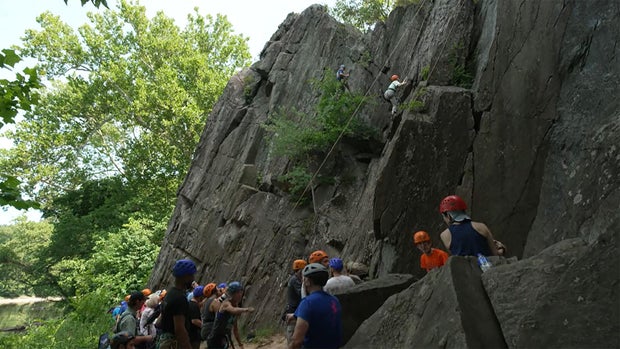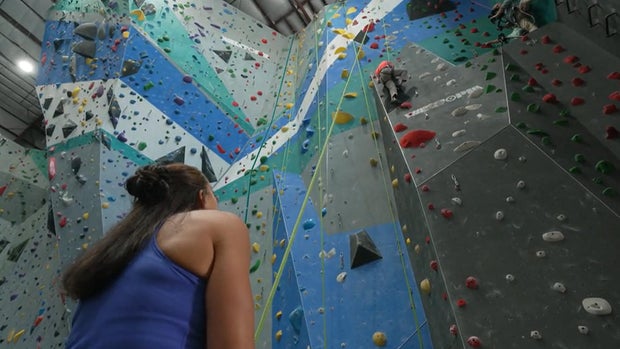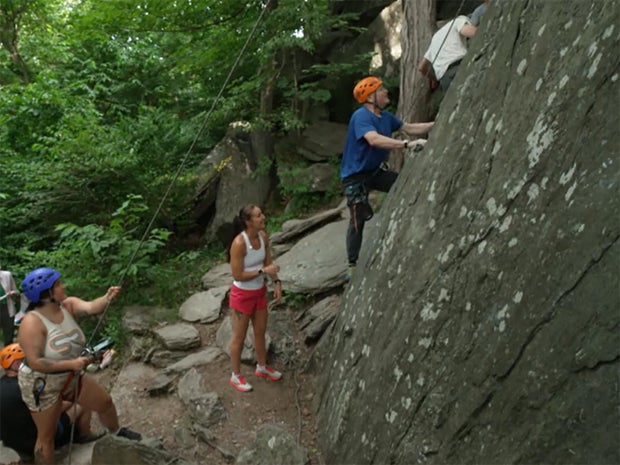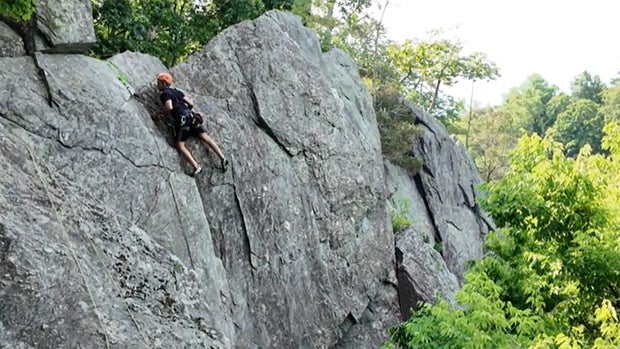CBS News
Combating Parkinson’s with rock climbing

We were amazed at what we were seeing on a sweltering summer’s day, when a group of people with Parkinson’s Disease began rock-climbing on the Carderock Cliffs of Maryland. Yes, rock-climbing!
It’s all part of their therapy, says Molly Cupka, the no-nonsense instructor and cheerleader for this community of courageous climbers.
CBS News
She started this program, called UpENDing Parkinsons, as a non-profit twelve years ago.
“There’s a lot of balance involved, mobility involved, strength, cardio, and then there’s the cognitive part, where you have to look at the hold, and figure out how to get your body to move to get to that hold,” she said.
How often do they fall? “Falling is definitely part of climbing,” said Cupka. But they never really fall, because they wear a harness that provides a layer of safety. “You’re always on the rope. You fall, but you don’t fall far. We always say if you’re not falling, you’re not trying hard enough!”
There’s no cure for Parkinson’s, which usually affects mobility, coordination, balance, and even speech. Jon Lessin was diagnosed in 2003. He was once an all-around athlete. About 12 years ago he retired as a cardiac anesthesiologist because of Parkinson’s. His daughter, Brittany, watched his steady decline, until he discovered climbing walls as high as 60 feet!
“My dad has a hard time walking across the room, but he can make it to the top of this giant wall,” Brittany said. “There’s a lot that he’s had to give up because of his disease. But this is something that he found through it, which is really cool.”
CBS News
Jon said, “I get to the top and I feel like I’ve conquered something. And I feel like the wall can’t beat me. I can beat the wall.”
Full disclosure: This story is very personal to me. My late husband, Aaron Latham, had Parkinson’s, and boxed as a way to fight the symptoms, as he explained on “Sunday Morning” in 2015. “Boxing’s just the opposite of Parkinson’s,” said Latham. “Everything’s designed, instead of to shrink you, everything’s designed to pump you up.”
Jon Lessin said Parkinson’s “makes you feel very small. You make small movements, you’re hunched over. And [rock climbing] makes you feel like you can accomplish the world.”
It was Lessin who first had that big idea to use rock climbing as a therapy for Parkinson’s. “I wanted to do big-movement exercise,” he said. “And I found Molly at this gym.”
Lessin proposed the idea to Molly Cupka, who runs the Sportrock Climbing Center in Alexandria, Virginia. She thought it was worth a try, given the sport requires participants to plan ahead, to know where to position their hands and feet. “I wish I could go into the brain and see what’s happening while people climb,” Cupka said.
Some people with Parkinson’s, like Vivek Puri, get dyskinesia (involuntary jerking motions). Puri said he’s usually unaware of his. He runs a home building company in the D.C. area, and was only 38 when he found out he had Parkinson’s. “Fine motor skills have kind of really suffered dramatically,” he said. “When I don’t climb for some periods of time, I get worse.”
But once he gets on the wall, he calls himself Spider-Man.
CBS News
“Honestly, I climb like a monkey,” he said. “I get my finger strength moving, which gets my fine motor skills – maybe not back, but kind of keeps that in motion.”
There’s no evidence climbing slows the progress of Parkinson’s, but Cupka joined forces with Marymount University last year to study patients climbing for the first time. “We have people literally walking and carrying weights, you know, walking and looking, multitasking,” she said.
The study found that, in so many words, if you climb, you may walk better.
Mark de Mulder, a musician and former director of the National Geospatial Program, doesn’t need a study to prove what climbing does for him. “It allows me to say, ‘All right, take that, Parkinson’s! I’m doing this!’ It just makes me feel stronger, and I’m fighting it. I’m doing something about it.”
CBS News
Many of the climbers have become friends who climb together several times a week; and they’ve become a support group, Parkinson’s Pals, who encourage each other.
“When I reach the top, I can turn around and look and wave, and see my wife and my friends, and that’s the reward,” said de Mulder. “It’s really wonderful.”
There’s no real understanding of how these people can do this, but you can certainly understand why. An emotional Vivek Puri said, “It’s nice to be good at something.”
CBS News
For more info:
Story produced by Richard Buddenhagen and Kay Lim. Editor: George Pozderec.
See also:
CBS News
Biden lifts restriction on Ukraine’s use of U.S.-provided weapons inside Russian territory
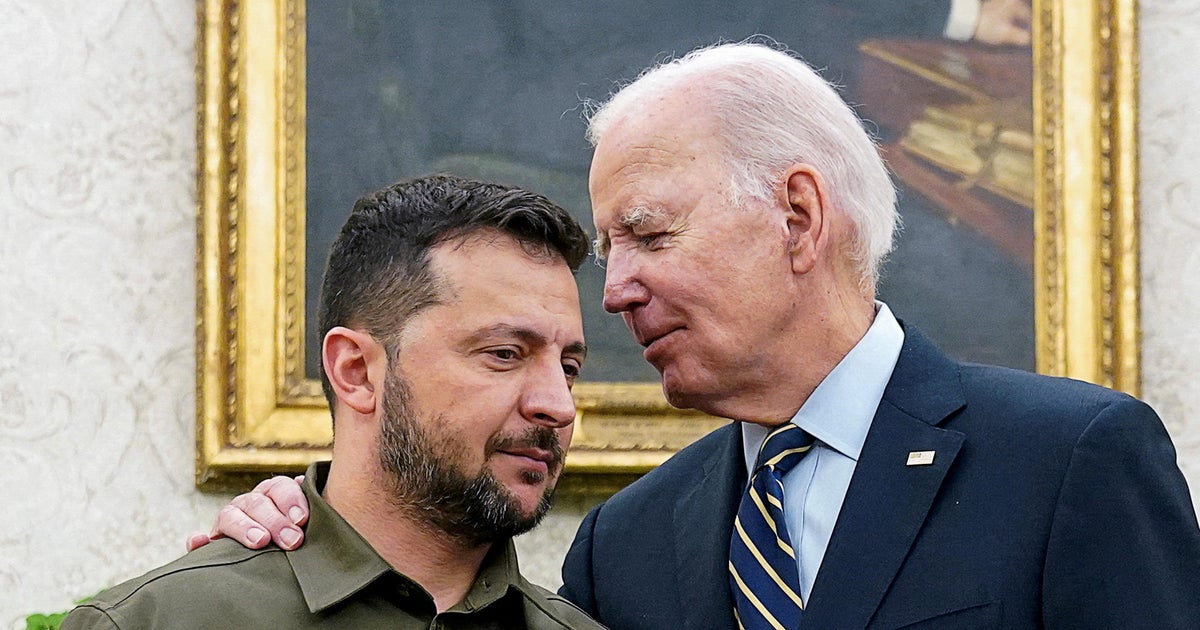
President Biden has given the OK to lift restrictions that will allow Ukraine to use U.S.-provided long-range weapons to strike deep into Russian territory, a U.S. official confirmed to CBS News on Sunday. The move is a significant change to U.S. policy in the ongoing Ukraine-Russia conflict.
The easing of restrictions would allow Kyiv to use the Army Tactical Missile System, or ATACMS, to hit targets inside Russia. The move also comes as some 10,000 North Korean troops were sent to Kursk near Ukraine’s northern border to help Russian forces retake territory.
The White House National Security Council declined to comment to CBS News.
The U.S. decision could help Ukraine at a moment when Russian forces appear to be making gains and could put Kyiv in a better negotiating position when and if peace talks happen.
It also comes as Mr. Biden is about to leave office and President-elect Trump has pledged to limit American support for Ukraine and ending the war as soon as possible.
In an interview with Ukrainian media outlet Suspilne on Friday, President Volodymyr Zelenskyy said Kyiv would like to end the war with Russia next year through “diplomatic means.”
He said he is certain that the war will end “sooner” than it otherwise would have once Mr. Trump becomes president.
“It is certain that the war will end sooner with the policies of the team that will now lead the White House. This is their approach, their promise to their citizens,” Zelenskyy said.
February 2025 would mark the third year of Moscow’s invasion of Ukraine with Russia’s troops gaining ground in recent months.
For several months, Zelenskyy and many of his Western supporters have been requesting to use U.S. weapons to hit Russian military targets far from its border, saying the U.S. ban had made it impossible for Ukraine to try to stop Russian attacks on its cities and electrical grids.
Some congressional Republicans have urged Mr. Biden to loosen the rules on how Ukraine can use U.S.-provided weapons.
contributed to this report.
CBS News
Ohio governor, other leaders condemn neo-Nazi march in Columbus: “Your hate isn’t welcome in our city”

Leaders in Ohio condemned a group of neo-Nazis parading around part of Columbus carrying flags with swastikas on Saturday afternoon.
Columbus public safety dispatchers told CBS affiliate WBNS on Saturday that they received multiple 911 calls around 1:30 p.m. about a group of individuals marching in the city’s Short North.
Video sent to the station showed nearly a dozen people wearing black pants, shirts and head coverings and red masks covering their mouths marching down the street. Three of the people were carrying black flags with red swastikas.
It was not immediately clear who was in the group.
Hours after the incident, Mayor Andrew Ginther released a statement saying the city rejects the “cowardly display” and that it “stands squarely against hatred and bigotry.”
“We will not allow any of our neighbors to be intimidated, threatened or harmed because of who they are, how they worship and whom they love,” Ginther said in his statement shared on X.
The city’s attorney, Zach Klein, said in a statement on X that those involved in the neo-Nazi march should “take your flags and the masks you hide behind and go home and never come back. Your hate isn’t welcome in our city.”
“This is not who we are, and we will not tolerate or normalize this disgusting ideology in any form,” he added.
Gov. Mike DeWine said in his own statement that the people involved in the incident were “spewing vile and racist speech against people of color and Jews.”
“There is no place in this State for hate, bigotry, antisemitism or violence, and we must denounce it wherever we see it,” he said.
Columbus Division of Police Sgt. Joseph Albert told WNBS that there were no arrests made, although he noted that many of the individuals were detained but later released.
Columbus, Ohio’s largest city, is located roughly 45 minutes from Springfield, where the Columbus Dispatch reported that neo-Nazis marched through the streets this summer as the city became the focal point of false claims about Haitian immigrants in the presidential election.
CBS News
11/17: Face the Nation – CBS News

Watch CBS News
Be the first to know
Get browser notifications for breaking news, live events, and exclusive reporting.


